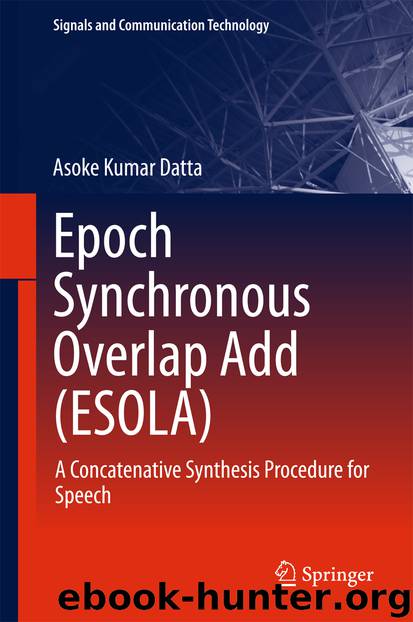Epoch Synchronous Overlap Add (ESOLA) by Asoke Kumar Datta

Author:Asoke Kumar Datta
Language: eng
Format: epub
Publisher: Springer Singapore, Singapore
St-Ph
Time span (ms)
Correlation values for
WS
SA
PRAAT
CSL
240–560
0.971168
0.974487
0.975192
0.965396
660–810
0.94085
0.910521
0.867612
0.359852
910–1030
0.405241
0.756702
0.791934
0.05897
1130–1840
0.958024
0.445712
0.947273
0.434311
1940–2380
0.825291
0.20005
0.249977
0.33895
3.6 Classification Results
Table 3.8 represents the confusion matrix of classification done using method detailed in Sect. 3.2, of the steady state signals into all the 12 phone classes. These 12 classes consists of 7 vowels, 1 lateral, 2 nasal murmurs and two sibilants. It may be noted that the rows for /a/, /e/ and /i/ includes the classification done through sub-class representation as indicated in Sect. 3.2. For Tables 3.8, 3.9 and 3.10 the number in each cell corresponds to the number of windows. Each steady state contains a large number of windows. These are small and of different length (each equal to a pitch period) for vocalic signal. For sibilant signals the windows are of equal length i.e. of 20 ms. The data within the three boxes indicated by cells with italicised characters in Table 3.8 represent the confusion matrix for the 12-class classification. The boxes therein shows the confusion within the groups namely Group I, II, III defined below.Table 3.8Confusion matrix for 12 phone classes of steady state signals
Download
This site does not store any files on its server. We only index and link to content provided by other sites. Please contact the content providers to delete copyright contents if any and email us, we'll remove relevant links or contents immediately.
Algorithms of the Intelligent Web by Haralambos Marmanis;Dmitry Babenko(8332)
Test-Driven Development with Java by Alan Mellor(7004)
Data Augmentation with Python by Duc Haba(6925)
Principles of Data Fabric by Sonia Mezzetta(6661)
Learn Blender Simulations the Right Way by Stephen Pearson(6569)
Microservices with Spring Boot 3 and Spring Cloud by Magnus Larsson(6431)
Hadoop in Practice by Alex Holmes(5973)
Jquery UI in Action : Master the concepts Of Jquery UI: A Step By Step Approach by ANMOL GOYAL(5829)
RPA Solution Architect's Handbook by Sachin Sahgal(5823)
The Infinite Retina by Robert Scoble Irena Cronin(5521)
Big Data Analysis with Python by Ivan Marin(5499)
Life 3.0: Being Human in the Age of Artificial Intelligence by Tegmark Max(5182)
Pretrain Vision and Large Language Models in Python by Emily Webber(4460)
Infrastructure as Code for Beginners by Russ McKendrick(4247)
Functional Programming in JavaScript by Mantyla Dan(4059)
The Age of Surveillance Capitalism by Shoshana Zuboff(3979)
WordPress Plugin Development Cookbook by Yannick Lefebvre(3956)
Embracing Microservices Design by Ovais Mehboob Ahmed Khan Nabil Siddiqui and Timothy Oleson(3757)
Applied Machine Learning for Healthcare and Life Sciences Using AWS by Ujjwal Ratan(3730)
